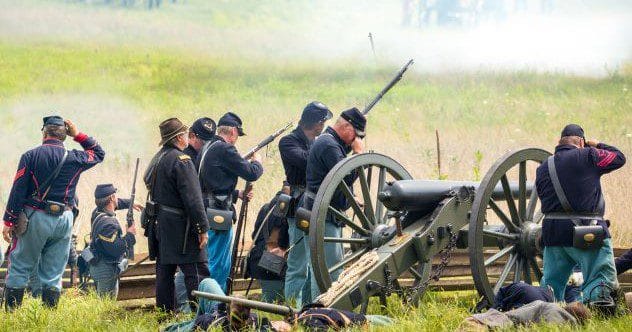The American Civil War, a defining period in U.S. history, often conjures images of iconic battles and key figures. While many know the basics, a closer look reveals fascinating details often overlooked in standard narratives. From innovative military technologies to the war’s surprising impact on everyday life, these lesser-known facts offer a fresh perspective on this pivotal conflict.
Let’s dive into ten surprising facts about the Civil War that might just change how you see this period.
10. Hot Air Hideaway
Both the Union and Confederate armies used hot air balloons for reconnaissance. These balloons, like the Union’s Intrepid and the Confederacy’s Gazelle, soared up to 1,000 feet. From this height, observers could spot enemy positions and relay information using telegraphs or signal flags, providing a crucial advantage on the battlefield. It was an early form of aerial surveillance. [1]
9. Submarine History
In 1864, the Confederate submarine H.L. Hunley made history by becoming the first sub to sink an enemy ship. Off the coast of Charleston, South Carolina, the Hunley successfully attacked and sank the Union’s Housatonic. Despite this achievement, the Hunley itself sank shortly after the attack, highlighting the experimental and dangerous nature of early submarine warfare. [2]
8. Ironclad Innovation
The Battle of Hampton Roads in March 1862 marked the first time ironclad ships engaged in combat. The Union’s USS Monitor and the Confederacy’s CSS Merrimack (renamed Virginia) battled to a standstill, signaling a major shift in naval warfare. This clash demonstrated the obsolescence of wooden warships and ushered in the era of ironclad vessels. [3]
7. Wait, How Old?!
Johnny Clem, known as the “Drummer Boy of Shiloh,” was one of the youngest soldiers in the Civil War. He ran away from home at age nine to join the Union Army. Initially a mascot and drummer, Clem later officially enlisted and even saw combat. His story highlights the extreme circumstances and youthful involvement in the war. [4]
6. Cold, Hard Cash
The Civil War prompted the U.S. government to issue its first paper currency, known as “greenbacks.” These notes were intended to finance the war effort, but they were initially met with skepticism due to uncertain financial backing. The introduction of greenbacks marked a significant step in the evolution of American monetary policy. [5]
5. Stash Your Stamps!
During the Civil War, rampant inflation, especially in the Confederacy, led to a shortage of coins. People began using postage stamps as currency because they had a set value for specific services. The U.S. government even introduced “postage currency”—small paper bills featuring stamp illustrations—to address the need for small denominations. [6]
4. The Worst Day Ever
The Battle of Antietam, fought on September 17, 1862, remains the bloodiest single day in American military history. Over 23,000 soldiers were killed, wounded, or missing in action. The battle’s staggering casualties underscored the immense human cost of the Civil War. [7]
3. Did You Make That at Home?
While the Union army generally had standard-issue uniforms, Confederate soldiers often wore mismatched clothing due to supply shortages. Southern soldiers frequently relied on homespun garments, leading to a variety of colors and styles. Union soldiers derisively nicknamed their Confederate counterparts “butternuts” because of the color of their clothing. [8]
2. The Great Locomotive Chase
In April 1862, Union soldiers attempted to sabotage Confederate supply lines by hijacking a train in Georgia. Known as the Great Locomotive Chase, this daring raid aimed to disrupt Confederate communications and logistics. Although the mission ultimately failed, it became a legendary tale of Civil War espionage and adventure. [9]
1. New Mexico’s Civil War History
The Battle of Glorieta Pass in New Mexico, often called the “Gettysburg of the West,” was a crucial engagement that thwarted Confederate ambitions in the Southwest. In March 1862, Union forces halted a Confederate advance aimed at seizing control of Colorado’s gold mines and key ports in California. This victory secured the West for the Union. [10]
These ten facts offer just a glimpse into the many lesser-known aspects of the American Civil War. From the skies to the seas, and in the everyday lives of soldiers and civilians, the war was a period of innovation, desperation, and profound change.
What other surprising facts about the Civil War do you know? Share your thoughts in the comments below!










